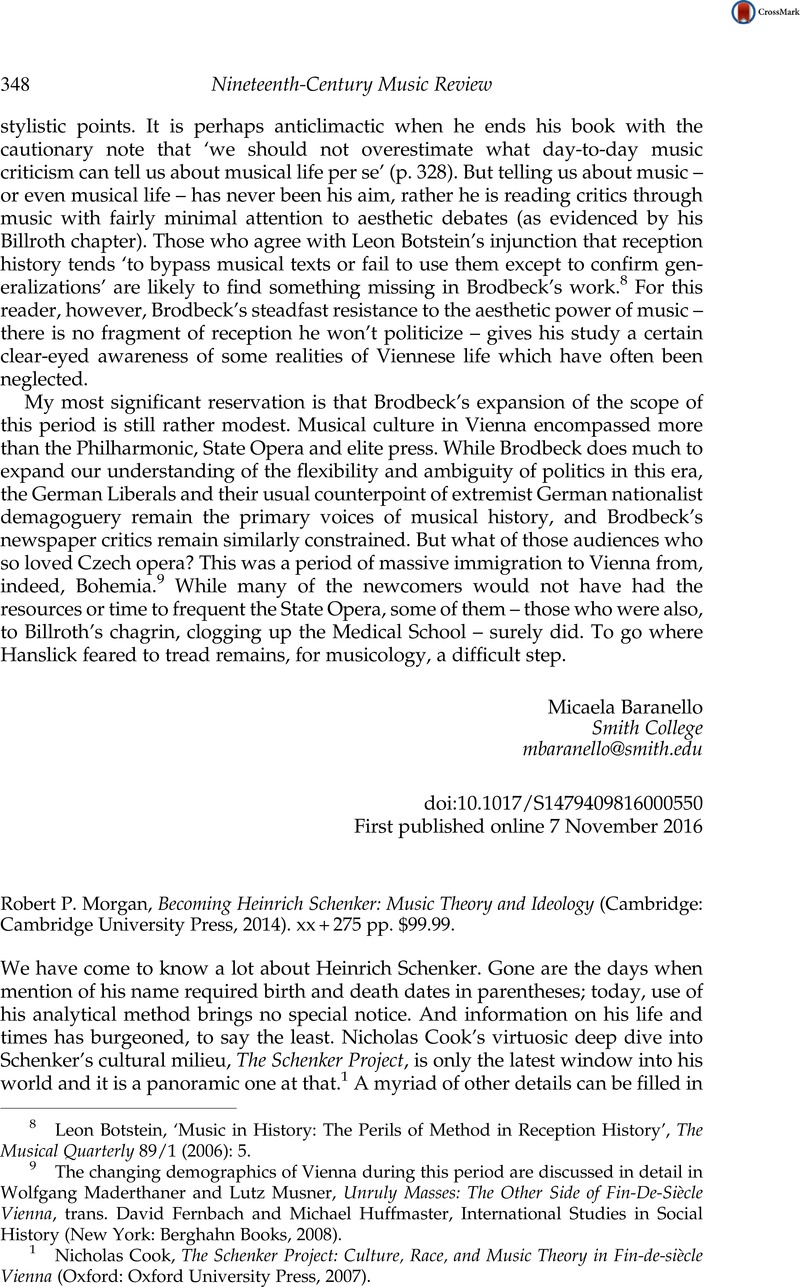No CrossRef data available.
Published online by Cambridge University Press: 04 November 2016

1 Cook, Nicholas, The Schenker Project: Culture, Race, and Music Theory in Fin-de-siècle Vienna (Oxford: Oxford University Press, 2007)CrossRefGoogle Scholar.
2 Schenker Documents Online, www.schenkerdocumentsonline.org/index.html (accessed 31 May 2016). See also the selection of letters from this website published as Heinrich Schenker: Selected Correspondence, ed. Ian Bent, David Bretherton and William Drabkin (Martlesham: Boydell & Brewer, 2014).
3 The essay is frequently cited in Cook, with a revised translation by William Pastille in an appendix; see Cook, The Schenker Project, 319–32.
4 Schenker, Heinrich, Harmony, ed. and annotated Oswald Jonas, trans. Elisabeth Mann Borgese (Chicago: University of Chicago Press, 1954)Google Scholar.
5 Schenker, Heinrich, Harmonielehre (Berlin and Stuttgart: J.G. Cotta, 1906; rep. Vienna: Universal, 1978)Google Scholar.
6 A valuable feature of this book is the inclusion of extensive quotations of Schenker in translation and with German originals in an appendix, often providing fuller context. In this case, however, the reference to the pedal point is present in Morgan’s appendix but not mentioned in his text (p. 69, n. 30; see Harmony, p. 141, and Harmonielehre, p. 183).
7 Schenker, Heinrich, Counterpoint, 2 vols, trans. John Rothgeb and Jürgen Thym, ed. John Rothgeb (New York: Schirmer, 1976)Google Scholar.
8 Translations of all four of the explanatory editions have recently appeared, after the publication of Morgan’s book, edited by John Rothgeb in four volumes with the umbrella title Beethoven’s Last Piano Sonatas: An Edition with Elucidation (Oxford: Oxford University Press, 2015).
9 Schenker, Heinrich, Der Tonwille: Pamphlets in Witness of the Immutable Laws of Music, Volume I: Issues 1–5 (1921–1923) and Volume II: Issues 6–10 (1923–1924), ed. William Drabkin, trans. Ian Bent, William Drabkin, Joseph Dubiel, William Renwick and Robert Snarrenberg (Oxford: Oxford University Press, 2004)Google Scholar; Schenker, Heinrich, The Masterwork in Music, 3 vols, ed. William Drabkin, trans. Ian Bent, Alfred Clayton, William Drabkin, Richard Kramer, John Rothgeb, Derrick Puffett and Hedi Siegel (Cambridge: Cambridge University Press, 1994, 1996, 1997)Google Scholar.
10 The analysis of Schubert’s Impromptu, op. 90, no. 3 in the same volume shows similar bracketing.
11 Schenker, Heinrich, Free Composition (Der freie Satz), trans. and ed. Ernst Oster (New York: Longman, 1979 [1935])Google Scholar.
12 It is worth mentioning that quite a number of Schenker’s very intricate sketches are reproduced beautifully, much more readably than in some translations of Schenker’s work.
13 The literature on rhythm and Schenkerian theory is large enough to merit its own bibiliography. A good starting point is David Carson Berry, ‘Schenkerian Theory in the United States’, www.gmth.de/zeitschrift/artikel/206.aspx (accessed 31 May 2016). Berry’s list of articles on rhythm begins with Morgan’s own 1978 contribution, ‘The Theory and Analysis of Tonal Rhythm’, Musical Quarterly 64/4 (1978): 435–73.